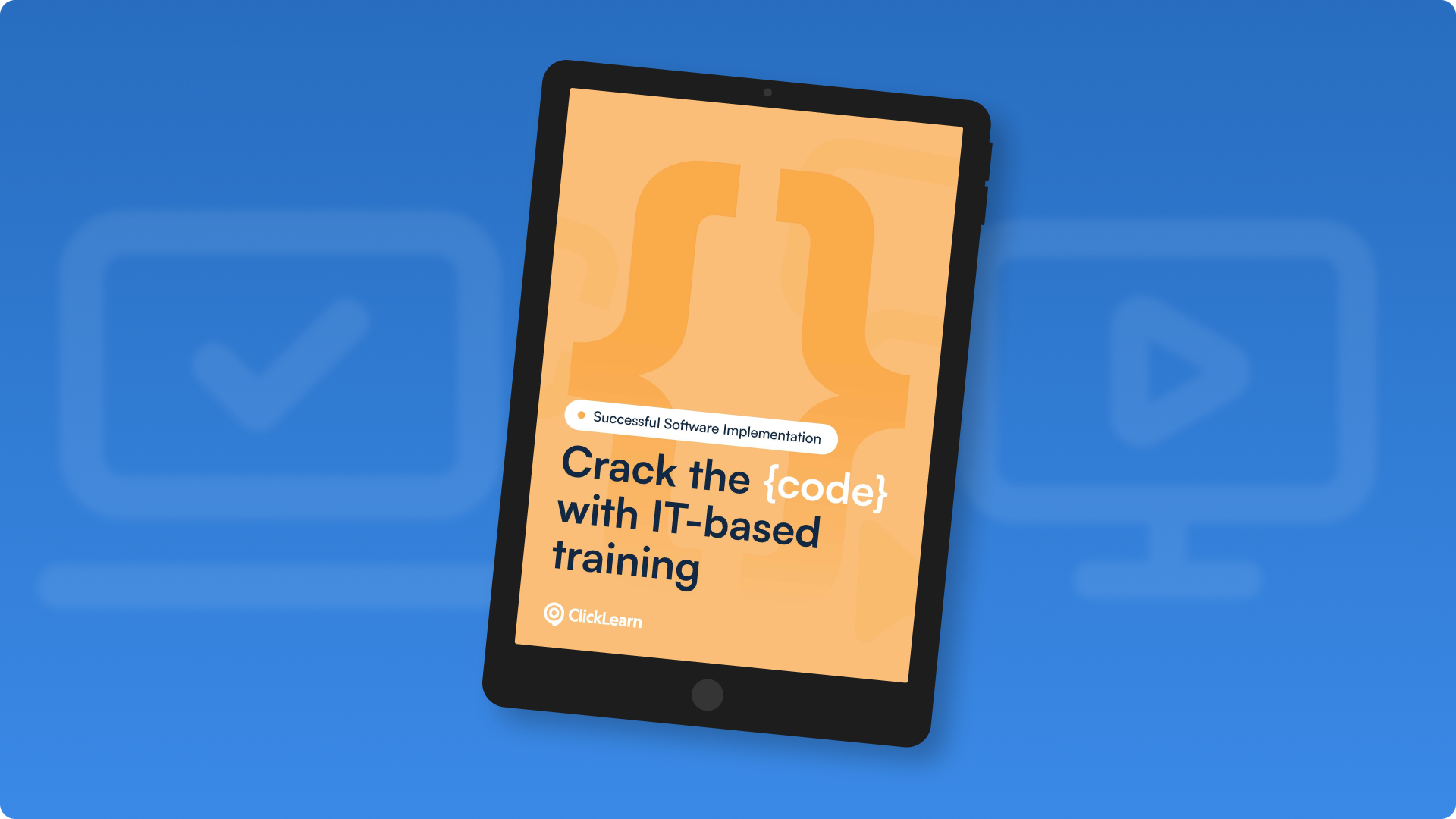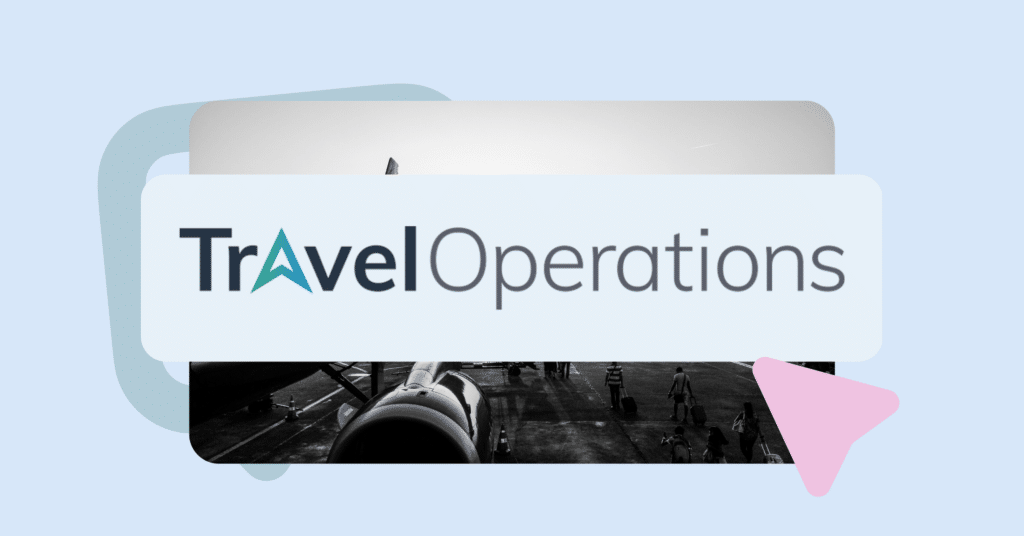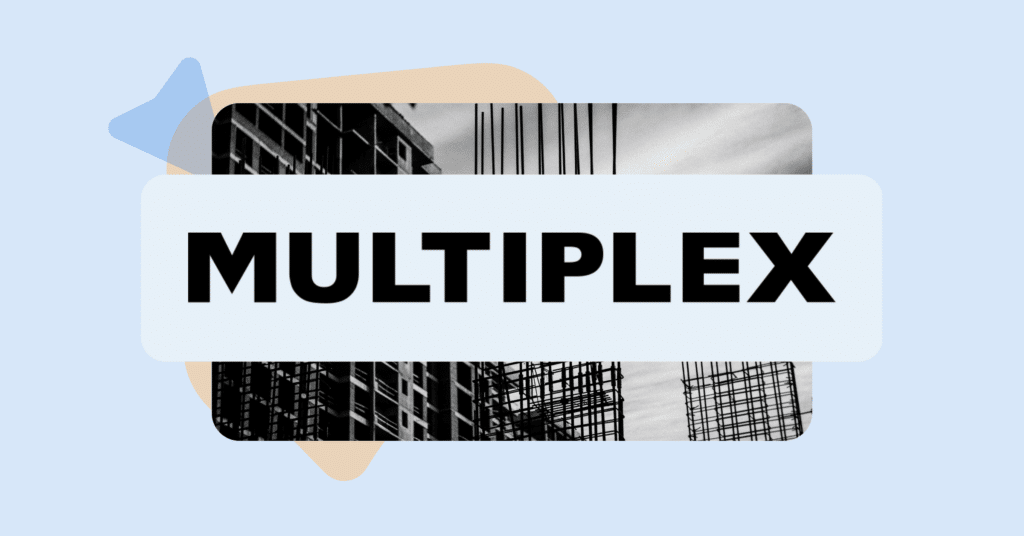Why best practices matter for software training?
When you’re training employees to use complex enterprise software – like CRMs, ERPs, or compliance systems – there’s a lot more at stake than knowledge retention.
Software training affects everything from productivity and user satisfaction to compliance, risk mitigation, and return on technology investments. If users don’t fully understand how to operate new systems, you’ll likely see:
Increased support tickets
Process bottlenecks
Compliance gaps
Slower time to value from your software
That’s why effective eLearning isn’t optional – it’s a strategic necessity.
Unlike traditional instructor-led training, eLearning offers scalability, flexibility, and repeatability. But to work well – especially in software contexts – it needs to be thoughtfully designed, consistently updated, and embedded in your learners’ day-to-day flow of work.
By adopting best practices tailored for software-heavy environments, you ensure that users not only learn the system – but actually use it as intended.
Top 8 eLearning best practices for enterprise software training
1. Align eLearning goals with business objectives
Effective training starts with clarity. Before you open your authoring tool or outline your first lesson, ask:
What business outcomes should this training drive?
For software training, your goals shouldn’t just be “get people to use the tool.” Instead, tie learning outcomes to real, measurable results. For example:
Reduce ticket handling time by 20% in a new helpdesk system
Ensure 95% of sales reps can correctly enter deals in the CRM within their first week
Decrease data-entry errors in the ERP system by 40% after onboarding
These types of goals serve two purposes:
They give structure and focus to your training content
They demonstrate value to stakeholders and leadership
Aligning with KPIs also makes it easier to evaluate whether your training worked – something that’s especially important when rolling out costly enterprise platforms.
🎯 Tip: Collaborate with process owners, team leads, and compliance officers when identifying training goals. Their input helps prioritize what’s most critical in the system – and avoids bloated, “train on everything” courses that drain time without improving performance.
When you have a clear line of sight from learning to business impact, you can prioritize content that matters most – and deliver it in the most effective way.
2. Design engaging, bite-sized content (microlearning)
No one likes sitting through an hour-long training on how to use a dropdown menu. Especially not in fast-paced environments where employees already juggle meetings, deadlines, and multiple systems.
That’s why microlearning – short, focused modules – is one of the most effective eLearning strategies for software training.
Instead of creating long courses that try to teach everything at once, break down training into:
5–10 minute lessons
Each focusing on one task, one feature, or one process
Delivered just-in-time, when users need it
For example:
“How to create a new customer record in the CRM”
“Submitting an expense report in the new finance system”
“Checking order status in the ERP dashboard”
These are practical, task-based topics that employees actually use – and learn better when delivered in short bursts. In fact, studies show microlearning can improve retention by up to 30% and significantly boost completion rates.
Additionally, microlearning fits well into a busy workday. It allows for flexible, on-demand training, reduces cognitive overload, and is easier to update when your software changes.
⚡ ClickLearn helps accelerate microlearning development by letting you record a single software process once – and then automatically generating bite-sized videos, clickable guides, and printable instructions from it. This makes microlearning scalable, even for small training teams.
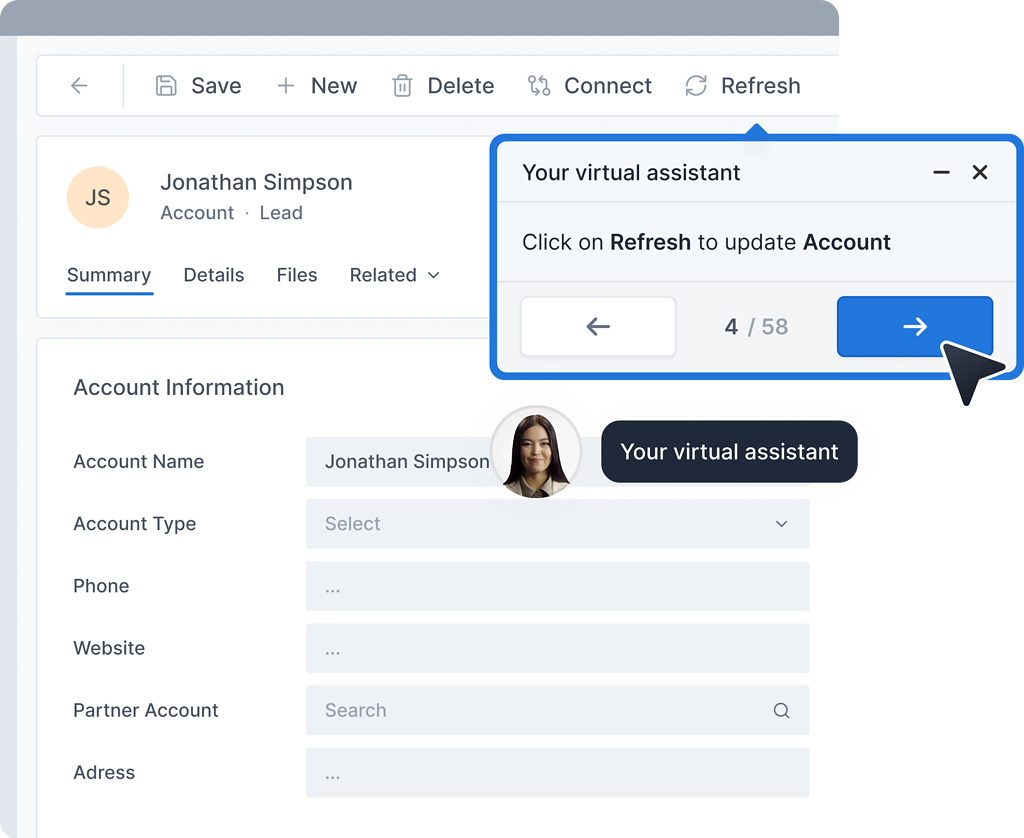
3. Use realistic scenarios and software simulations
Learning theory is helpful – but what really sticks is doing.
One of the most effective ways to train users on new software is by embedding learning in realistic workflows. Instead of abstract descriptions, show learners exactly what they’ll need to do on the job.
For example:
Rather than explaining how approval workflows work, walk them through approving a request in the system
Instead of listing user permissions, simulate assigning access rights in the admin dashboard
Instead of writing a policy on secure file uploads, demonstrate the correct process in your DMS
Scenario-based learning engages users with real-world context, while interactive simulations let them make mistakes in a safe environment. For new users, that’s a huge confidence booster. Scenario-based eLearning helps users apply what they’ve learned and reinforces long-term retention – especially for tools they may not use every day.
🔧 ClickLearn lets you create realistic walkthroughs and simulations by recording a task once in your software. You can then deliver it as a clickable guide, a simulation, or even as a narrated video – ensuring users get hands-on experience without touching production data.
This kind of hands-on training is especially valuable in enterprise software rollouts, where the margin for error can be costly.
4. Ensure accessibility, personalization, and mobile-friendly delivery
If your eLearning content isn’t accessible to everyone – or isn’t optimized for how people actually consume it – you’re creating barriers before learners even begin.
Start with accessibility:
Use high-contrast text and readable fonts
Add captions to all videos and transcripts for audio content
Ensure navigation is possible via keyboard and compatible with screen readers
Avoid relying solely on color to convey meaning (e.g. red = wrong, green = right)
Making your training accessible isn’t just good practice – it’s often a legal requirement, especially for public sector and international organizations.
Next, consider personalization. In complex software environments, different roles use different parts of the system. Your eLearning should reflect that.
Instead of a one-size-fits-all course, build learning paths based on:
User roles (e.g., sales rep vs. finance analyst)
Seniority or system permissions
Business unit or geography
🎯 For example: a global CRM rollout might include different walkthroughs for end-users, power users, and system admins—all within the same overall training program.
Finally, don’t ignore mobile-friendliness. Increasingly, learners expect to complete training:
On their phone or tablet
During downtime between tasks
Without needing a full desktop setup
Responsive design, lightweight file sizes, and tap-friendly interactions all support learning on the go.
💡 ClickLearn-generated content is automatically responsive and accessible across devices. It also supports multi-language output – making it easier to scale training across global teams.
These features aren’t just “nice to have” – they ensure that training actually reaches, supports, and serves your entire workforce, no matter their context.
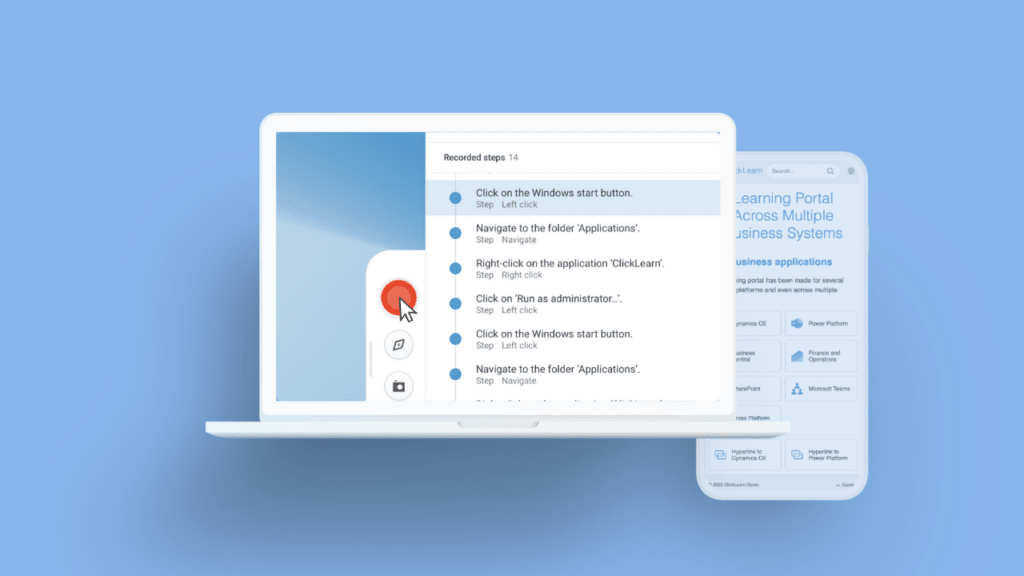
5. Provide multi-format content and on-demand support
Different people learn in different ways. Some prefer watching a video, others like written step-by-step guides. Some want a printable PDF they can reference offline. Others need a quick, clickable walkthrough while they’re in the software.
The best eLearning programs meet learners where they are by offering content in multiple formats, such as:
Short video demonstrations
Printable instructions or PDFs
In-app walkthroughs or tooltips
Interactive simulations
Slide decks or one-pagers
This flexibility:
Increases learner engagement
Supports neurodiverse users or those with varying needs
Enables better retention by offering reinforcement in various forms
It’s also essential for on-demand support. Learners may not remember every detail from an onboarding course – but if they can look it up while doing the task, they’re far more likely to succeed. This is known as performance support – and it’s especially useful for infrequent or high-stakes tasks (like submitting a GDPR request or configuring system settings).
💡 ClickLearn enables you to record a task once and automatically generate multiple outputs – video, written guide, PDF, slideshow, and even in-software help. That means less work for training teams and more value for learners.
The more accessible and flexible your training content, the more likely it is to be used – especially when learners need it most.
6. Incorporate continuous feedback, assessments, and analytics
How do you know if your eLearning is working?
It’s not enough to track course completions. You need to understand:
Are users retaining what they’ve learned?
Can they apply it correctly in the software?
Are they using the new tools more effectively post-training?
To get there, build in:
Quizzes and knowledge checks after each module
Practical exercises (e.g. “Complete this task in a simulated environment”)
Surveys or feedback forms asking learners what worked and what didn’t
Performance data: have support tickets dropped? Are key workflows being completed correctly?
Modern LMSs and digital adoption platforms can offer insights like:
Drop-off points in content
Most frequently replayed sections
User behavior post-training (e.g. increased usage of a feature)
Armed with this data, you can refine your training over time – improving both the learner experience and the outcomes that matter to the business. eLearning isn’t a one-and-done event – it’s a continuous improvement cycle. Build in feedback loops to keep it relevant and effective.

7. Foster a learning culture and support from leadership
Even the most perfectly designed eLearning course will fall flat if your organization doesn’t support a culture of learning.
In many companies, employees skip training not because they don’t care – but because they’re overwhelmed, uncertain of its value, or simply not encouraged to prioritize it. That’s why building a learning culture is one of the most overlooked (but powerful) best practices.
Here’s how to make it stick:
Get leadership buy-in. When managers take the training themselves, talk about it in meetings, and give their teams time to complete it, participation rates rise.
Normalize ongoing learning. Don’t treat training as a one-time event. Frame it as part of professional development, system updates, or career growth.
Encourage peer learning. Create Slack channels, forums, or “power user” groups where employees can share tips and ask questions.
Recognize and reward. Even small gestures—like digital badges, certificates, or shoutouts in meetings – can boost engagement. In more structured programs, tie completions to performance reviews or role advancement.
🌱 A strong learning culture turns training from a “have to” into a “want to.” And in the context of software adoption, that mindset shift can make or break the rollout.
💡 ClickLearn’s ease of use enables subject-matter experts – not just L&D pro – to capture and share processes. That democratizes content creation and supports peer-led learning, reinforcing your culture from within.
8. Leverage the right technology: LMS, DAP, and content tools
Great training doesn’t happen by accident – it’s powered by the right tools.
Your eLearning tech stack should support every stage of the learning lifecycle:
Content creation and authoring
Distribution and accessibility
Tracking and analytics
Just-in-time reinforcement
Here’s what to consider:
Use an LMS (Learning Management System) for assigning training, tracking completions, and managing certifications. Make sure it supports SCORM/xAPI standards, mobile access, and user segmentation.
Use a DAP (Digital Adoption Platform) to bring training into the flow of work – right inside the software people are learning. DAPs guide users in real time and provide just-in-time support for tasks.
Use authoring tools that reduce manual effort. Ideally, you want tools that let you create once and publish everywhere – video, text, slideshow, in-app, and more.
Choosing the right technology not only saves time – it scales your impact and ensures consistency across training programs.
Adopt eLearning best practices to your training program and improve digital adoption
Whether you’re onboarding employees to a new CRM, rolling out updates to your ERP, or standardizing workflows across global teams, effective eLearning is the key to successful software adoption.
By applying these eight best practices – from setting clear goals and using simulations, to offering multi-format content and embedding support directly in your tools – you can move beyond check-the-box training and create real behavior change.
Done right, eLearning:
Boosts user confidence and autonomy
Reduces support load and compliance risk
Increases software ROI across your organization
And you don’t have to do it all manually.
With solutions like ClickLearn, you can scale high-quality, engaging software training without sacrificing your time or sanity.
💡 Want to see how ClickLearn supports these best practices in action? Explore how we help companies simplify and scale enterprise software training – no matter how complex the system or global the team. Book your demo today.
FAQs on best eLearning practices
Use clear goals, microlearning, realistic scenarios, accessible and mobile-friendly content, multi-format delivery, continuous feedback, and the right tools like LMS and DAPs.
Keep content short and interactive, personalize learning paths, use assessments, gather feedback, and embed support directly into the software experience.
A DAP provides real-time, in-app guidance so learners can apply knowledge instantly without leaving the software.
It increases retention, fits into busy schedules, and makes complex topics easier to digest by focusing on one task at a time.
Update content at least annually, or whenever software, processes, or regulations change to keep training accurate and relevant.
